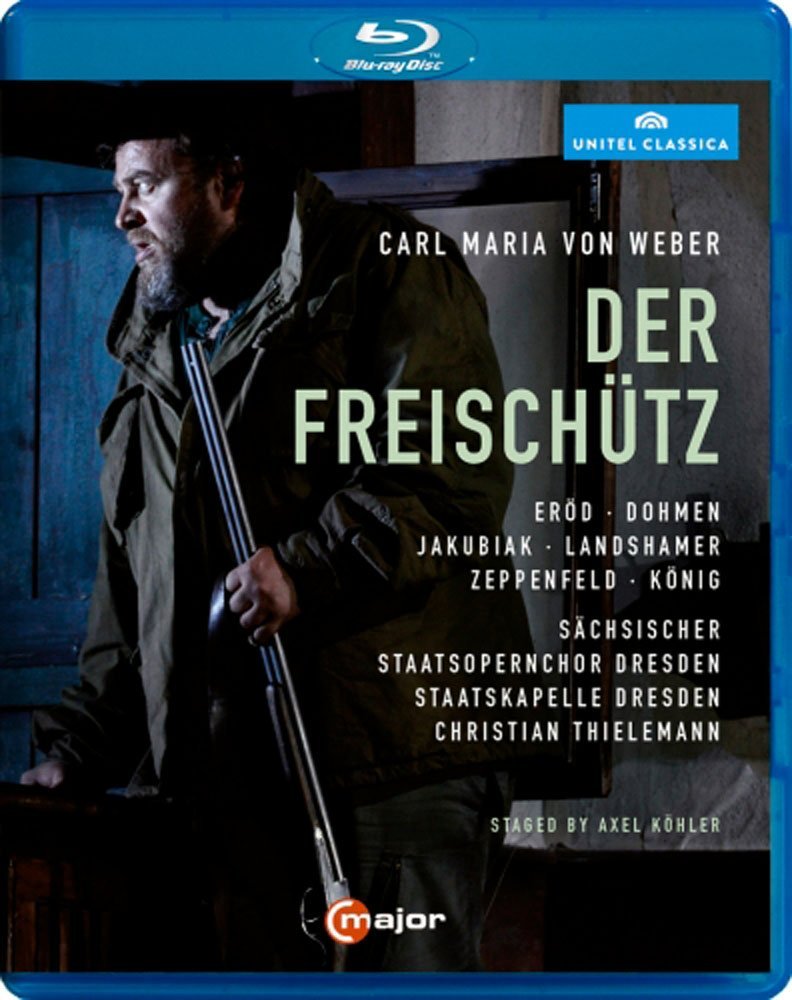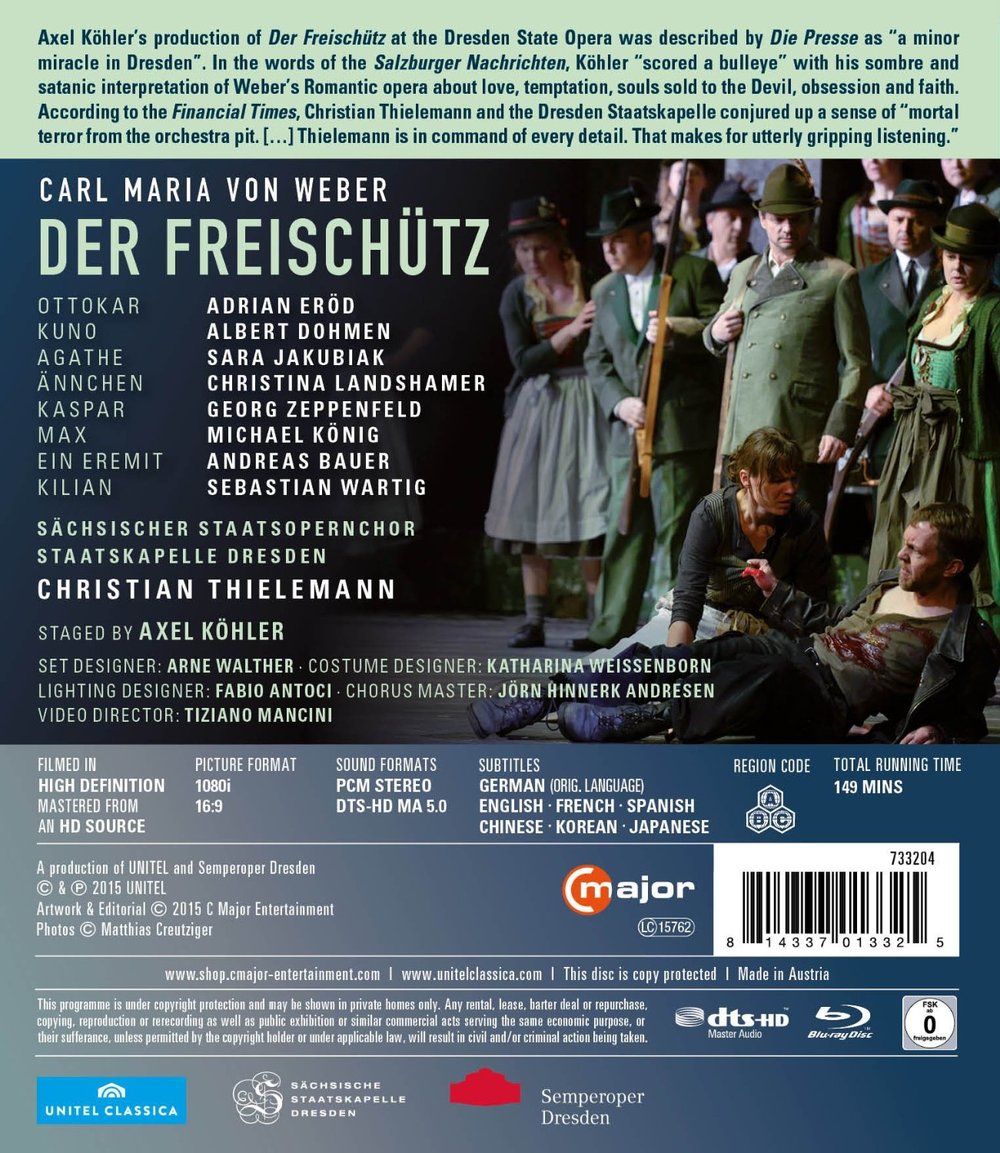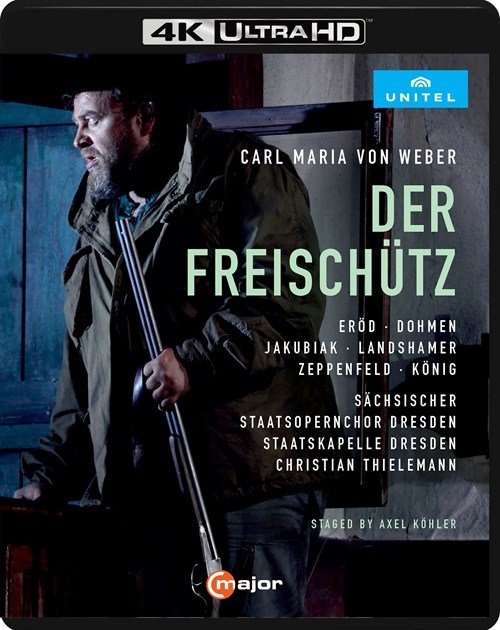


Carl Maria von Weber Der Freischütz opera to libretto by Friedrich Kind. Directed 2015 by Axel Köhler at the Semperoper Dresden. Stars Adrian Eröd (Ottokar), Albert Dohmen (Kuno), Sara Jakubiak (Agathe), Christina Landshamer (Ännchen), Georg Zeppenfeld (Kaspar), Michael König (Max), Andreas Bauer (Hermit), Sebastian Wartig (Kilian), Anna Katharina Schumann (Lame Woman), Gabriele Berke, Rahel Haar, Jana Hohlfeld, Heike Liebmann (Bridesmaids), Falk Joost, Markus Hansel, and Fritz Feilhaber (Hunters). Christian Thielemann conducts the Sächsischer Staatsopernchor and Staatskapelle Dresden (Chorus Master Jörn Hinnerk Andresen). Solo viola by Sebastian Herberg; solo cello by Norbert Anger. Set design by Arne Walther; costume design by Katharina Weissenborn; lighting design by Fabio Antoci; video designs by Arne Walther and Knut Geng; dramatic advice by Werner Hintze; choreography by Katrin Wolfram; fight direction by Klaus Figge. Directed for TV by Tiziano Mancini. Sung in German. Released 2015, disc has 5.0 dts-HD Master Audio sound. Grade: D+
This was recorded in early May 2015 and released in November 2015—that's fast! During November 2015 and January 2016, this production was still on the boards in Dresden (with a different conductor and cast). So if you couldn't hop on your jet in 2015-16 to see this in Dresden, you could still see it at home and be up-to-date!
Weber wrote Der Freischütz in Dresden and it has been performed there about 1500 times. It was the last work seen at the Semperoper before it was destroyed in 1945 in the bombing of Dresden, and it was the first work performed in the rebuilt Semperoper in 1985. So opera lovers in Dresden are very familiar with the libretto and music of Der Freischütz.
All reviews I read about this in 2015 were ecstatic about the performances of the Dresden Opera Orchestra and Chorus under Christian Thielemann. However, Axel Köhler's harshly updated mise-en-scène and odd personal directing were controversial. Still, it appears this production of the opera was well received by the Dresden live audience. (At this writing in December 2015, 4 performances scheduled for January 2016 are sold out.)
We already have a fine opera movie with a traditional romantic version of Der Freischütz, full of black-magic and supernatural events, renamed Hunter's Bride. I urge you to read my Hunter's Bride story before reading more of this review.
The Dresden Der Freischütz (shot live on stage) is set in contemporary times (more or less) in an unidentified location. There is a forest of huge trees in the background and all the structures we see on stage are ruins. Everything is unrelentingly dark, dirty, and daunting as the locals apparently attempt to recover from the disasters of war. This would resonate, of course, with the people of Dresden, who suffered vast devastation late in WW II. But Köhler's vision could not be set in Dresden in 1945 or later. After WW II, Dresden was in the Russian sector crawling with secret police, there were few men around healthy enough to even hold a gun, and no militias existed that could engage in target practice. But wherever we are, we see below a peasant lad winning a shooting contest:
The loser is Max (Michael König), a professional hunter and assistant forest manager for the local government. For the shot below, the main lights are dimmed and a spotlight is on Max:
Now Kuno (Albert Dohmen), the head Forest Manager, arrives with his militia to learn that Max lost the contest. The militia desperately needs some training in the safe handling of firearms. And look at all the peasants cowering in little groups. All this has to be intended to make us think of Einsatzgruppen in Eastern Europe, of ethnic cleaning in the Balkans, and fighting now in the Middle East. This is a pretty heavy load to dump on the shoulders of poor Carl Maria von Weber. And the lack of light here is also is a real nightmare for poor Tiziano Mancini, the videographer who has to try to make a film of this:
Mancini is one of the best in our business, but the dim lighting throughout almost every second of this show results in very weak resolution and PQ throughout the whole recording. Below we see the villain Kaspar (George Zeppenfeld) and Max, who agrees to go to the Wolf's Glen to improve his aim by making a deal with the devil:
Finally we meet Kuno's daughter Agathe (Sara Jakubiak) and her younger cousin Ännchen (Christina Landshamer). Max wants to marry Agathe and replace Kuno as the Head Forester (a package deal). But first he must win a shooting contest coming up the next day:
As you can see from the next screenshot below, Köhler and his team insist on making everybody and everything in this production as ugly as possible. Is attending this opera some kind of penance for the people of Dresden?
Kasper asks the devil (Samiel) for help in making magic bullets:
By cutting a cheap-looking hole in the boards, Köhler avoids having to melt and pour lead on stage (to cast bullets):
Below we see Agathe singing what is perhaps the high point of the opera, her Kavatine "Und ob die Wolke sie verhülle." She expresses her faith in God and love, which can be found behind the darkest cloud. Köhler does his best to minimize the impact of Agathe's song by swallowing her in almost unfathomable gloom:
Weber gives Ännchen opportunity to brighten up the show a bit with a humorous tale designed to amuse Agathe. But what young soprano could cut through this hideous set to get a laugh or even just a smile from the audience?
The bridesmaids. They all look like they've just finished 10 days chipping and cleaning bricks from collapsed buildings. This must be more penance for the citizens of Dresden, a few of whom in 1945 probably in fact stayed alive by working the brick heaps:
And now the guild of hunters and the Prince meet to watch the shooting contest. Front on the stage you see groups of children---girls on the left and boys on the right. They are going to enact a little scene to entertain the elders:
The girls line up pretending to be forest animals. The boys, great sports all, pretend to shoot them down:
The girls all have some fur or antlers. The boys use their knives to take trophies of pelt and horn from the girls:
The boys deliver the trophies to the preening, supercilious, and foppish Prince (Adrian Eröd):
Some of the reviewers found this hunting scene charming. I thinks it's perverse and disgusting. What do you think?
Here's the Prince again exhorting Max to win the shooting contest and take Agathe as his trophy. Where have we seen this Prince character before? What is the director doing here? I'll put it this way: if someone ever writes an opera about the rise and fall of Adolf Hitler and his supporters, then Adrian Eröd would be the perfect guy to call on to create the role of Dr. Joseph Goebbles:
The Prince challenges Max to shoot a white dove in a tree. The Devil sends the bullet toward Agathe, but her bridal veil deflects the bullet further. Still Agathe is down! But nobody on stage goes to her aid or to see if she's wounded or dead. I would say this is the most wooden and inept directing I've ever seen in an opera. Critic Shirley Apthorp was there and explains (for the May 5, 2015 Financial Times) why the stage often seems to be frozen in still life: "The singers [are] most of the time rooted to one spot on the stage staring at the conductor. This is not really Axel Köhler's Freischütz. This is Christian Thielemann's Freischütz."
Even after Agathe revives herself, everyone, including Max and Kuno, stand about like a petrified forest. Why not just do a concert version and cut the price of the ticket with the savings?
The Hermit (Andreas Bauer) tries to straighten things out while Max and his sweetheart stand apart and look on passively:
Why did the live audience in Dresden like this production (even when it was not being conducted by Thielemann)? Well, the German audience is sophisticated and supports new and controversial opera designs. Opera lovers in Dresden have seen Der Freischütz in traditional garb and may be happy to see something different. And the human eye can adjust to low light more easily than a video camera, so the stage probably didn't look as dark live as it does in my HT or in these screenshots. The orchestra and chorus probably did a great job at all times and a memorable job when Thielemann was conducting. The worst one could say about the singers is that they meet the standard of "acceptable mediocrity," and the recording and SQ on the disc are fine. So if you really want to have Thielemann's conducting or there is some other special reason to want to have this, buy it.
But I can't think of any reason for the rest of my readers to to invest in this disc as long as the Jen Neubert's Hunter's Bride is available. For me the strange directing, poor acting, ugly designs, bad lighting, and week video resolution rule this title out. I would go so far as to say that this video should not have been made. A nice CD of the music would be welcome. So under the grading guidelines we follow, this could be an "F" title. But there might be some readers, especially in Germany, who would go for the Köhler approach together with the Theilemann contribution, so I'll put the grade at D+.
This title came out originally in 2K (also called 1080i). Later it was also issued in a 4K version, which we haven’t seen.
To buy the 2k Blu-ray, click below:
OR
To buy the 4-K version:
or




















